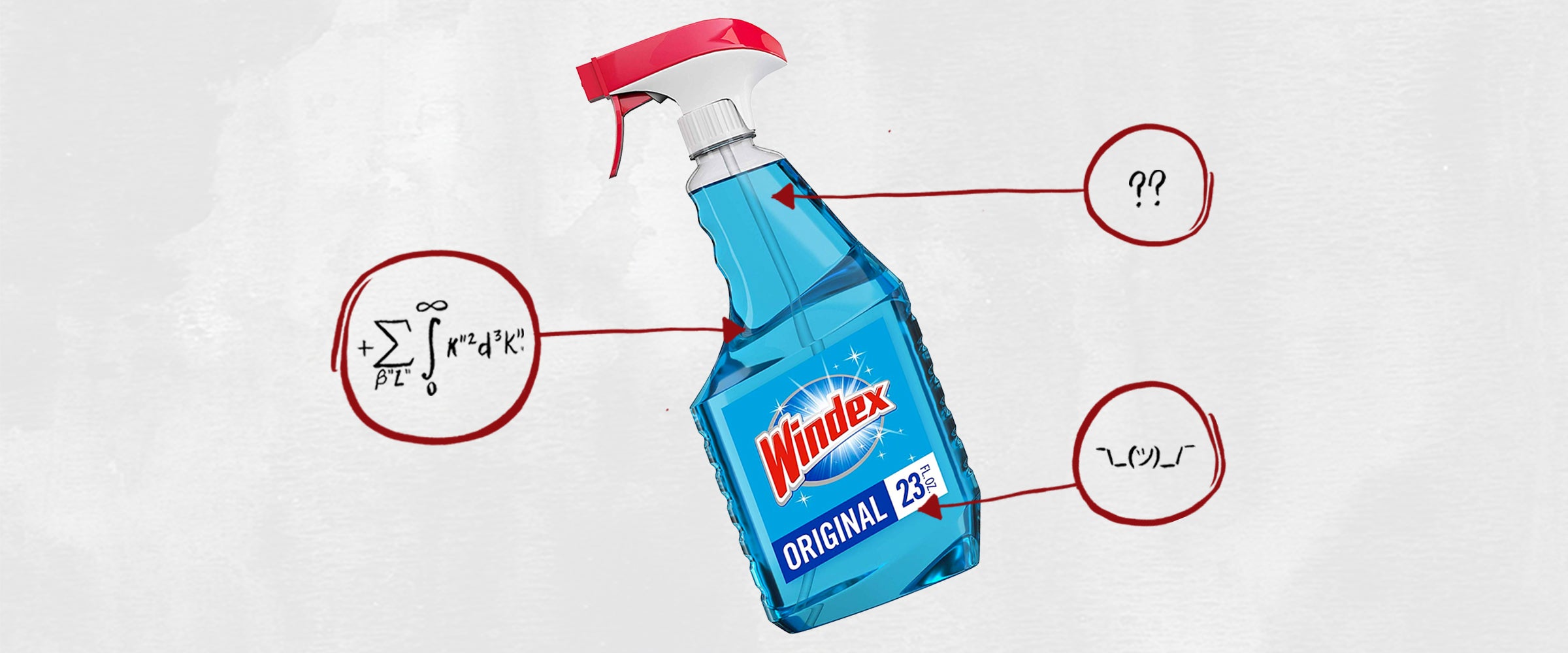We’re often told that you should never eat anything (or put anything on your body) if you don’t recognize everything on the ingredients list. But since most of us have no idea what xanthan gum or potassium benzoate are — or more importantly, what they’re doing to our bodies — we’re decoding the ingredients in the many things Americans put in (and on, or near) themselves.
This edition: Windex Original Glass Cleaner, which is made from eight separate ingredients that we’ve broken down in the exact order they appear online.

The Ingredients
1) Water: This provides a base for the other ingredients. It’s wet!
2) 2-Hexoxyethanol: This is frequently added to cleaning products as a surfactant. In simple terms, that means it loosens dirt and other unpleasant deposits from surfaces so they can be easily rinsed away. Keep in mind, however, that most surfactants — and there are many in Windex — can irritate the eyes, skin and lungs.
3) Isopropanolamine: This is also found in many cleaning products, since it can dissolve oils and soap residue. Again, though, isopropanolamine is pretty damn toxic when ingested or sprayed directly on the skin.
4) Ammonium Hydroxide: This is more commonly known as ammonia, which can be found in all sorts of cleaning products as a degreaser. Ammonia is particularly suited for cleaning windows since it evaporates quickly and leaves no residue that might dry into streaks on the glass. Of course, ammonia can be extremely toxic in large amounts when breathed in, so avoid spraying Windex anywhere near your face.
5) Lauryl Dimethyl Amine Oxide: Similar to 2-hexoxyethanol, this ingredient cleans by loosening gunk from surfaces so it can be easily removed.
6) Sodium Dodecylbenzene Sulfonate: Much like 2-hexoxyethanol and lauryl dimethyl amine oxide, this is a surfactant.
7) Fragrance: Unlike many manufacturers who take advantage of the fact that fragrance recipes are considered to be proprietary information, Windex actually lists the ingredients in its fragrance: Benzyl acetate, butylphenyl methylpropional, c9-11 pareth-3, citronellol, citrus aurantium dulcis (orange) peel oil, dipropylene glycol, ethoxydiglycol, hexyl cinnamal, linalool and terpineol.
Despite the lengthy list of crazy-sounding ingredients, none of this necessarily means you should be worried about this item. In fact, fragrance ingredients are regulated by the Consumer Product Safety Commission, so theoretically, they should be at least generally safe. That said, fragrances tend to be the leading cause of cosmetic contact dermatitis — a skin rash caused by contact with a certain substance. There’s an easy fix for that, though: Either stop spraying Windex on you skin, or try a different window cleaner next time around.
8) Liquitint® Sky Blue Dye: This is obviously what gives Windex its bright blue color. It’s pretty harmless.
The Takeaway
Windex does what it says: It gets crap off your windows. However, more and more research suggests that common household cleaners, especially those containing ammonia, are bad for both our health and the environment. Windex has even acknowledged this, releasing a vinegar-based version that should theoretically be safer for everyone.
In the meantime, though, just make sure to use Windex in a well-ventilated area to avoid any excess ingestion (i.e., open your, uh, windows). Also, even though it looks like blue Gatorade, drinking Windex will most likely cause your central nervous system to shut down, so maybe avoid that one, too.

